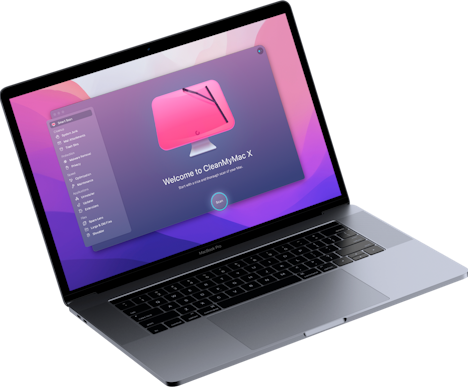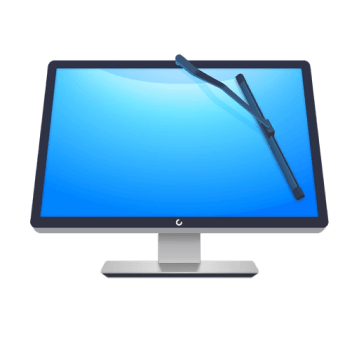How to repair disk permissions on Mac
Repairing disk permissions is commonly the first remedy in different troubleshooting guides, and for a reason. This easy fix indeed helps address numerous issues. But have you ever thought about what stands behind these mysterious disk permissions and how do you actually repair them? In this article, we’ll explain what disk permissions are as well as introduce two ways to repair them — automatic and manual.
What are disk permissions?
Disk permissions on macOS are used to keep your files secure. They’re designed so that certain programs (or other users if you share your Mac) can’t just dip into a system file they have no business with and modify it. They’d need permission to do that.
Every file and folder on your Mac comes with an associated set of permissions. From the Apple Community:
“Many things you install in Mac OS X are installed from package files (whose filename extension is “.pkg”). Each time something is installed from a package file, a “Bill of Materials” file (whose filename extension is “.bom”) is stored in the package’s receipt file, which is kept in /Library/Receipts/ in Mac OS X v10.5 and earlier. These files don’t take up much disk space and you shouldn’t put them in the Trash. Each of those “.bom” files contains a list of the files installed by that package, and the proper permissions for each file.”
Why permissions need repairing?
Unfortunately, disk permissions can easily become messed up unintentionally. It’s quite common for this to happen when installing and uninstalling apps on your system. And when it does, apps can find themselves with free reign to alter files and modify read-only files, which can cause all kinds of permission errors and system issues, such as lagging, freezing, or crashing.
If you notice anything out of the norm regarding system performance, the first thing you should do is troubleshoot those disk permissions. Some examples of out-of-the-norm behavior:
- Improper functioning of applications
- Inability to move or delete files
- Inability to access files
Below we’ll show you two ways to repair disk permissions: the easy one and the manual one. Choose the way that will work best for you.

How to repair disk permissions on Mac automatically
For users of macOS versions newer than El Capitan, the removal of Repair Disk Permissions means you have no troubleshooting solution to turn to if your Mac is ailing.
But worry not, CleanMyMac X is the hero you need. It does all of the heavy lifting for you to verify permissions and repair your Mac’s disk.
First things first, you’ll need to download CleanMyMac X. You can do that here for free. Once that’s done, follow these four steps:
- Open CleanMyMac X.
- Click on Maintenance from the left sidebar menu.
- Select the box next to Repair Disk Permissions.
- Click Run.
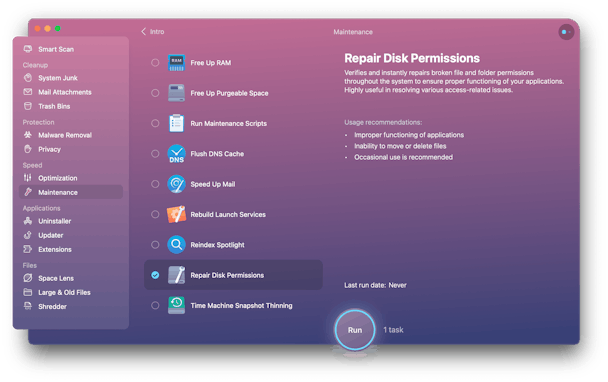
CleanMyMac X will scan your system to verify disk permissions and automatically repair permissions that are found to be faulty. When the task is complete, you’ll be able to view a log of all the permissions that were repaired.
And that’s all there is to it. Your Mac should now be running as intended. If your Mac appears to be running fine, it’s still worth running repairs every so often to ensure it stays that way. Not all broken permissions affect performance, but that doesn’t mean they shouldn’t be fixed.

How to repair permissions manually
If you’re running an older version of macOS, Disk Utility is the go-to tool for troubleshooting problems. Why an older version? Because as of macOS version 10.11 El Capitan, Disk Utility no longer comes with the option “repair disk permissions.”
But there’s a method to the madness. macOS now comes with a feature called System Integrity Protection (SIP), which is designed to automatically repair file permissions during software updates and system changes. SIP works by restricting the root account so that it can’t do things like modify protected locations and processes, such as /System and /usr. This should prevent malware from gaining root permissions and infecting your system files.
Anyway, back to using Disk Utility to repair disk permissions. If you’re running a pre-El Capitan version of macOS, follow these steps:
- Press Command + Space to open Spotlight, type in “Disk Utility,” and hit Return.
- Select Macintosh HD from the left sidebar menu.

- Click on the First Aid tab.
- Click on Verify Disk Permissions. By taking this step, Disk Utility will work through your hard drive to detect broken or misbehaving permissions and list them for repair. This might take a few minutes, but you can select the Show details box to keep an eye on its progress.
- Click on Repair Disk Permissions and wait while Disk Utility runs through the identified permissions to fix them.
If disk permission issues have played such havoc that your Mac won’t boot correctly, it’s possible to access Disk Utility in recovery mode. Do this by holding Command + R during bootup.
If you’re installing a newer (or older) version of macOS on top of your existing operating system, Mac will perform a disk permission repair as a part of the installation so that you start from a clean slate.

How to control permissions for specific apps
If you need to, you can control permissions for apps. All you have to do is right-click on an app or file you’re trying to access. In the menu that opens, click Get Info (alternatively, you can use the Command + I combination after clicking on the app or file once). See the Sharing & Permissions section. Here you can modify the permissions for Read or Write.
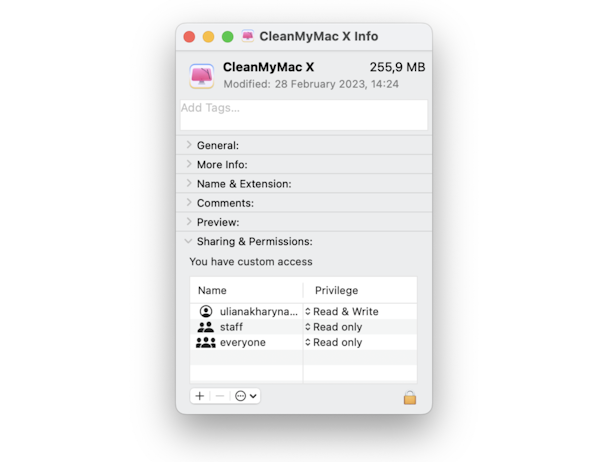
In some cases, though, you may receive the “You don’t have permission to open the application” error message. It is occasionally reported on newer macOS versions. It doesn’t allow you to run certain apps and, sadly, doesn’t explain which permissions are missing, so the first trick won’t work.
Luckily, it is easy to fix this error. Try the following one by one:
- Update macOS by going to System Settings > General > Software Update and following the on-screen instructions if an update is available.
- Update the app from the App Store, the Check for Updates option available from the menu bar when the app is open, or the developer’s website. If there is no update available, delete the app and reinstall it.
- Check installed profiles in System Settings > Users & Groups. Click the i next to the currently logged-in user and make sure that the Allow this user to administer this computer feature is turned on. You may need to Add Account if your current user does not have admin permissions.
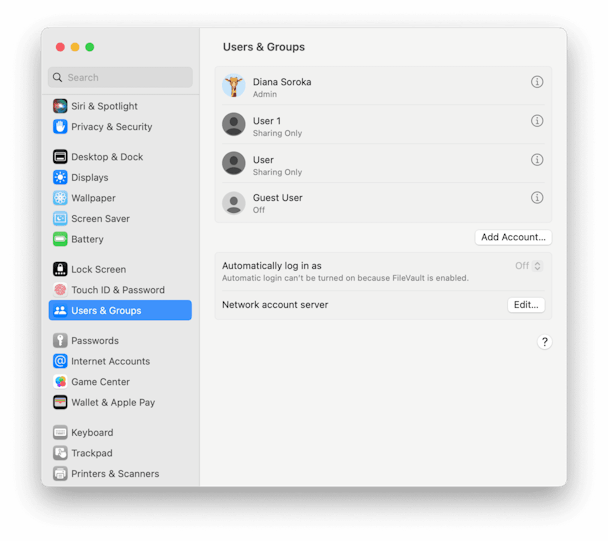
Hopefully, now you know what disk permissions are and how to repair them. Thank you for reading, and enjoy a clean, happy Mac!



